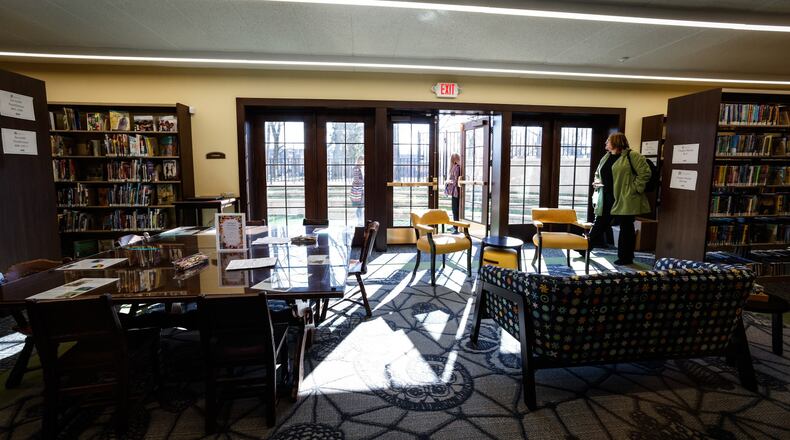For 2026, the state is allotting nearly $24.8 million for Montgomery County’s libraries through the PLF. This allocation is roughly 2% lower than the 2025 allocation.
Breakdown by library
The PLF funnels state dollars to Dayton Metro Library, Washington-Centerville Public Library, Wright Memorial Public Library and Germantown Public Library. Library leaders from all four library systems met and agreed upon a simpler funding split than in previous years, with all branches except Germantown Public Library rounding down their past percentages.
Dayton Metro Library, the county’s largest library system, will take home the largest slice of funding at 78.8%. This represents nearly $19.5 million.
Washington-Centerville Public Library is receiving 12.5% of the funding ($3.2 million), while Wright Memorial Public Library will receive 5.5% ($1.3 million). Germantown Public Library will receive 3.2% of the funding, or roughly $772,108.
| 2026 Percentage share | 2026 PLF net revenue estimate | 2025 Percentage share | 2025 PLF net revenue estimate | |
|---|---|---|---|---|
| Dayton Metro Library | 78.80% | $19,471,914.80 | 78.81% | $19,941,167 |
| Germantown | 3.20% | $772,108.64 | 3.09% | $783,001 |
| Washington-Centerville | 12.50% | $3,207,117.08 | 12.57% | $3,180,355 |
| Wright Memorial | 5.50% | $1,346,919.48 | 5.52% | $1,397,511 |
| Totals | 100.00% | $24,798,060.00 | 100.00% | $25,302,034 |
Source: Montgomery County Budget Commission
Public Library Fund
For decades, Ohio’s PLF received 1.7% of Ohio’s general revenue fund, which is powered by sales and personal income taxes and other revenue sources.
But the state’s $60 billion biennial budget, passed by state lawmakers this summer, converted the PLF into a line-item in the budget. The state appropriated $490 million for the 2026 fiscal year and $500 million for the 2027 fiscal year.
“The move from a designated percentage in the general revenue fund for the Public Library Fund to a line item, that’s something that should not be taken lightly. That move means that as a line item, that could go away completely,” said Montgomery County Auditor Karl Keith.
Representatives of all four library chains attended the Montgomery County budget commission meeting Thursday and voiced an uptick in demand for services, but fear over what’s to come with the rise in cost to deliver services and the rise of inflation.
Dayton Metro Library Fiscal Officer Westly Davis said the pivot to a line-item appropriation makes state funding for libraries less predictable than it once was, as it’s no longer linked to a percentage of state revenue.
“We have worked hard to manage expenses responsibly, including implementing cost-saving measures, but structural reduction to the PLF placed us at risk of deficit spending in future years,” Davis said. “Without predictable funding, we face difficult choices, including limiting services, reducing hours and postponing capital investments.”
Montgomery County voters approved a 5-year, 1-mill property tax levy last fall for the library to cover operational costs.
Usage up, concerns persist
Other libraries have also been tightening their belts amid state budget uncertainty.
Libraries are hubs for connection and growth in their communities, said Wright Memorial Library director Kristi Hale.
“Library programs are a lifeline for a lot of people,” she said.
Hale said funding the library is on track to receive through 2027 is less than what the library received in 2021. Inflation has increased by 19% over that period of time, she said.
Germantown Public Library, the smallest chain in the county, has implemented a vacancy freeze, a voluntary schedule reduction and reduced hours at its location from 61 to 50 hours per week, according to library executive director Greg Van Bebber.
Credit: Tom Gilliam
Credit: Tom Gilliam
“Our goal is a reduction of about 10% in salary costs and working hours for our staff by the end of 2026,” he said. “We’re going to be gradually using the end of 2025 and 2026 to make those cuts.”
But Van Bebber said people are using his library “at record levels” this year.
Washington-Centerville Public Library director Liz Fultz said library services are increasing in use as the community that surrounds her library also continues to grow residentially.
The library’s Creativity Commons makerspace at the Rec Plex in Washington Twp. saw 22,000 people use it in 2024. This year, the library is on track to see a 27% increase in interaction with that space, for instance.
Montgomery County Treasurer John McManus said the theme of usage is an important point to discuss with policymakers.
“There’s, I think, this narrative that perhaps library usage is down, and I know one of the things that we try to do as treasurers, as prosecutors, as auditors, as libraries, is convey a realistic narrative to the legislature so they can make informed decisions,” McManus said.
About the Author


